When you’re starting a new WooCommerce store, you’ll first have to choose a good WooCommerce theme. Depending on your wishes, you may also need a page builder to finetune your site’s design to your unique requirements. In this article, we have listed the fastest page builders for WooCommerce.
A page builder is a plugin that allows you to edit your site’s design in greater detail without writing any code. It offers more options and flexibility than a theme does.
In this article, we’re going to take a closer look at some of the most popular page builders and we’ll test which one is the fastest in combination with WooCommerce.
Do I need a page builder for my WooCommerce site?
Strictly speaking, you don’t need a page builder to create your website. WooCommerce has built-in templates to display all the necessary pages: the shop page, single product pages, account page, etc.
By default, these templates look quite basic, but that’s where your theme comes in. Your WooCommerce-ready theme has a built-in design that makes these e-commerce pages look good out-of-the-box.
Most good themes also offer additional options to customize their design further. You’ll be able to change your brand colors, update fonts, and choose font sizes.
If you’re happy with this limited choice of flexibility, you don’t need a page builder.
But what if you want greater control over the site’s design? What if you want to rearrange components, display additional sections, or create custom product landing pages?
In those scenarios, you’ll need a page builder to customize your design in greater detail.
Page builders are plugins designed to give you extra control over how your website looks and is organized, going beyond what themes can do. While they may take a little time to get the hang of, they make it easy for you to create your web pages without having to do any coding.
Whether you need a page builder depends on your goals, and how happy you are with the built-in design and options your theme offers.
| Type | ❌ | ✅ |
|---|---|---|
| With Page builder | Adds complexity and unnecessary features, leaving performance in the hands of the page builder’s developers. | Allows for greater control over your site’s design. |
| Without page builder | Limited design options. Custom changes require PHP and CSS skills if not supported by your theme. | Lightweight, best for SEO. |
Personally, we prefer to build websites without a page builder, as we will always favor performance.
Does WordPress come with its own page builder?
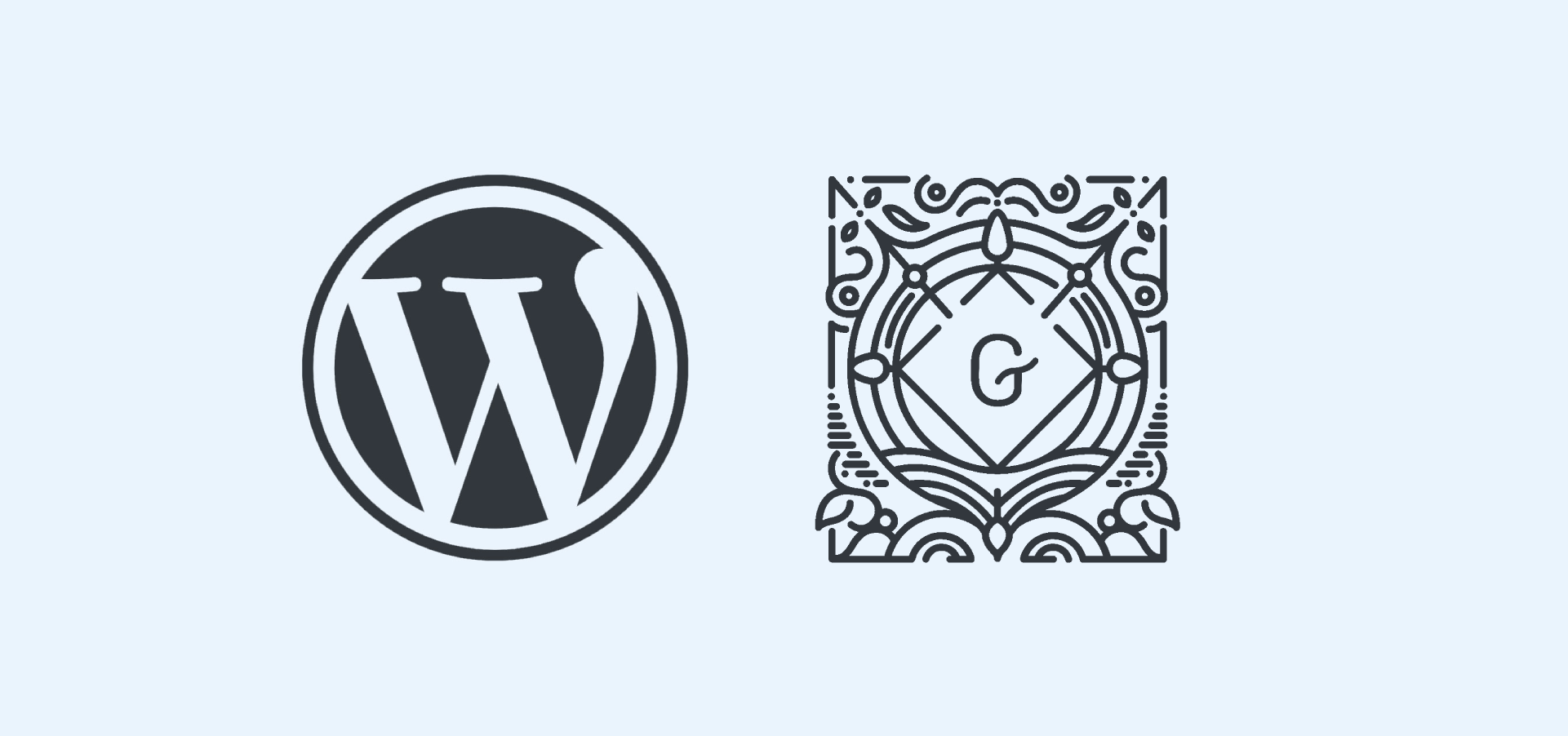
WordPress does not come with its own page builder by default. However, in 2023, WordPress launched “Full Site Editing” (FSE for short), which offers users a way to visually edit all aspects of their site (navigation headers, footers, and anything in between) using “blocks”. Blocks are individual layout components like:
- An image
- A paragraph
- A button
- …
While this is not the same as a full-fledged page builder (which offers even more control), this is a step in the right direction. Prior to 2023, there was no way to change the layout of specific pages unless your theme had specific options (or you wrote custom code).
Keep in mind that in order to use FSE, your theme has to enable this functionality.
TLDR
If you’re pressed for time, here’s the list showing the fastest page builders with WooCommerce:
| Page Builder | Ranking | PageSpeed Insights score | TTFB score | Average score |
|---|---|---|---|---|
| Full-Site Editing + Blocks | 1 | 97 | 74 | 85.5 |
| Breakdance | 2 | 100 | 70 | 85 |
| Elementor | 3 | 97 | 68 | 82.5 |
| Beaver Builder | 4 | 97 | 66 | 81.5 |
| Divi | 5 | 98 | 62 | 80 |
Should you use FSE over a page builder?
Full-Site Editing (FSE) is a step in the right direction, as WordPress now lets you have more control over how to structure your pages. You can add, rearrange, or remove blocks more easily, so you are not bound by the fixed layout WooCommerce or your theme ships with.
But, it’s not quite like full-fledged page builders that have more advanced design options. True page builders still have these features that FSE currently doesn’t have:
- Responsive settings: Page builders allow you to create responsive layouts by adding separate sections or settings for mobile devices only. Currently, WordPress FSE does not have this feature.
- Advanced design elements: Page builders often come with more advanced components that you can add to your pages, such as accordions, time lines, Google Map boxes, content sliders, etc.
- Pre-designed templates: Page builders allow you to import demo templates to start from. If you’re not in a creative mood, this helps you get started a lot quicker!
- Advanced styling options: Page builders will have more advanced options to style elements, like drop shadows or animations.
Moreover, it’s still quite finicky to use, so we can’t recommend it at this time.
How did we test website speed?
When evaluating the speed of different page builders in combination with WooCommerce, it’s important to maintain fairness in the tests. That’s why we created 5 different test sites (one for each page builder) on the same hosting and with the exact same configuration. Here’s how our test sites are set up:
- All test sites were hosted on the same host in the same location.
- Each test site was running WordPress version 6.4.3 and PHP 8.2.
- Only WooCommerce and any plugins required by the page builder were installed.
- No additional page optimizations were implemented.
- With each page builder, we created a single product page with the same type of components. This ensures all pages have the same layout and one doesn’t load more design components than the others.
The meaning of metrics
To test the speed of any theme builder, you will need to use the right performance-tracking tools available to you. Here are the popular tools we used during our testing:
- PageSpeed Insights: PageSpeed Insights (PSI) is popular amongst WooCommerce site owners as a benchmarking tool for site performance. Developed by the team at Google, it’s the best “source of truth” to find out how well your site is performing in terms of SEO, speed, usability, and accessibility. The higher your scores, the higher your chances of appearing in a better position on Google’s search results.
- Pingdom: This tool shows you the exact page load time (in milliseconds) as well as how large a page is (in terms of megabytes).
- KeyCDN’s TTFB tester: This tool measures the Time To First Byte (TTFB). We explain what this metric is and why it’s useful a little further down the article.
Each of these tools measures and displays specific information. We’ll quickly go over each metric so you know what you’re looking at. Warning: this part is quite technical!
Google PageSpeed Insights metrics
The analysis of PageSpeed Insights offers a lot of information. What we’re interested in most is the all-in-one Performance Score:
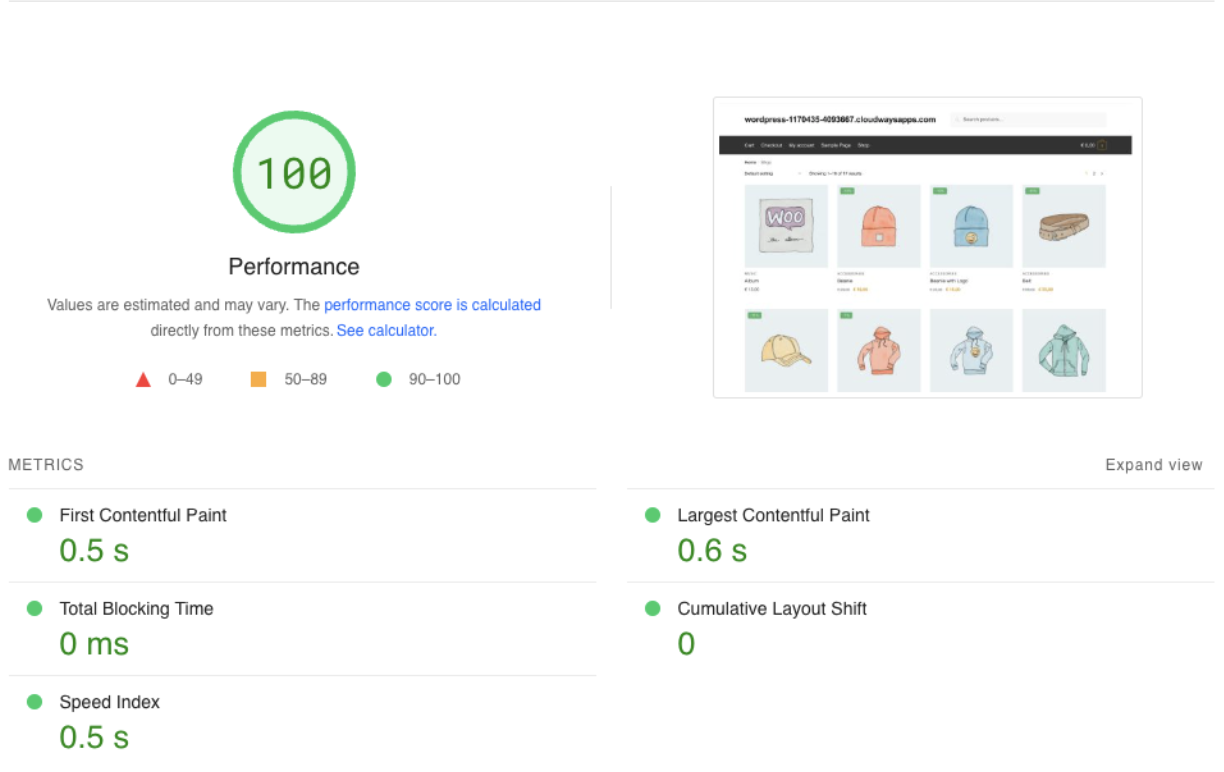
This is a number from 0 to 100 (the higher, the better) indicating the overall speed performance of your page. The score is a measure of this data:
- First contentful paint: This metric tells you how long it takes for the first image or text to appear while the website is loading. The lower the better.
- Speed index: Speed index measures how quickly content is visually displayed during page load. The lower the better.
- Largest contentful paint (LCP): This metric calculates how long it takes for the most prominent element or content block to appear on the page. Again, the lower this score, the better.
- Total blocking time (TBT): The total blocking time indicates the time a large process blocks the page so that visitors can’t interact with it. You want this score to be as low as possible (ideally zero).
- Cumulative layout shift (CLS): This measures the movement of visible elements while the page is loading.
Pingdom metrics
Pingdom shows 4 additional interesting metrics:
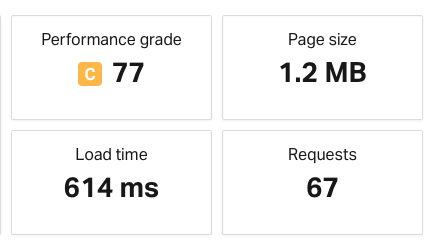
- Performance grade: This is an overall evaluation of how optimized a website is for speed based on factors like load time, page size, and the number of requests. This grade is a letter from A to F, where A is excellent and F is the worst possible score.
- Page size: This is the complete size of the page, including all assets such as HTML code, scripts, and images. A lower score is better.
- Load time: This is the total time your page needed to be fully loaded. This includes loading all included assets such as images and scripts.
- Requests: The number of requests during page load the browser makes to your server. A lower number is better.
The Time To First Byte (TTFB) metric
The Time To First Byte (TTFB) is the duration it takes for a user’s browser to receive the first byte of data from a web server after making a request. In easier words: this indicates how long your server is working to render the web page.
A high TTFB usually indicates that you have a slower host, or you are using a lot of plugins and they’re all doing something to render the page.
Logically, if your site is hosted in Europe, and someone is visiting from Australia, the TTFB will be higher because the distance between the visitor and the host is further away. That’s why we’ll measure the TTFB from a few different locations around the world and then take an average.
The fastest WooCommerce page builders
Now that you know how we test the fastest WooCommerce page builders, it’s finally time to dive in and look at the page builder plugins themselves and how they performed during our tests!
1. Full-Site Editing with WooCommerce Blocks
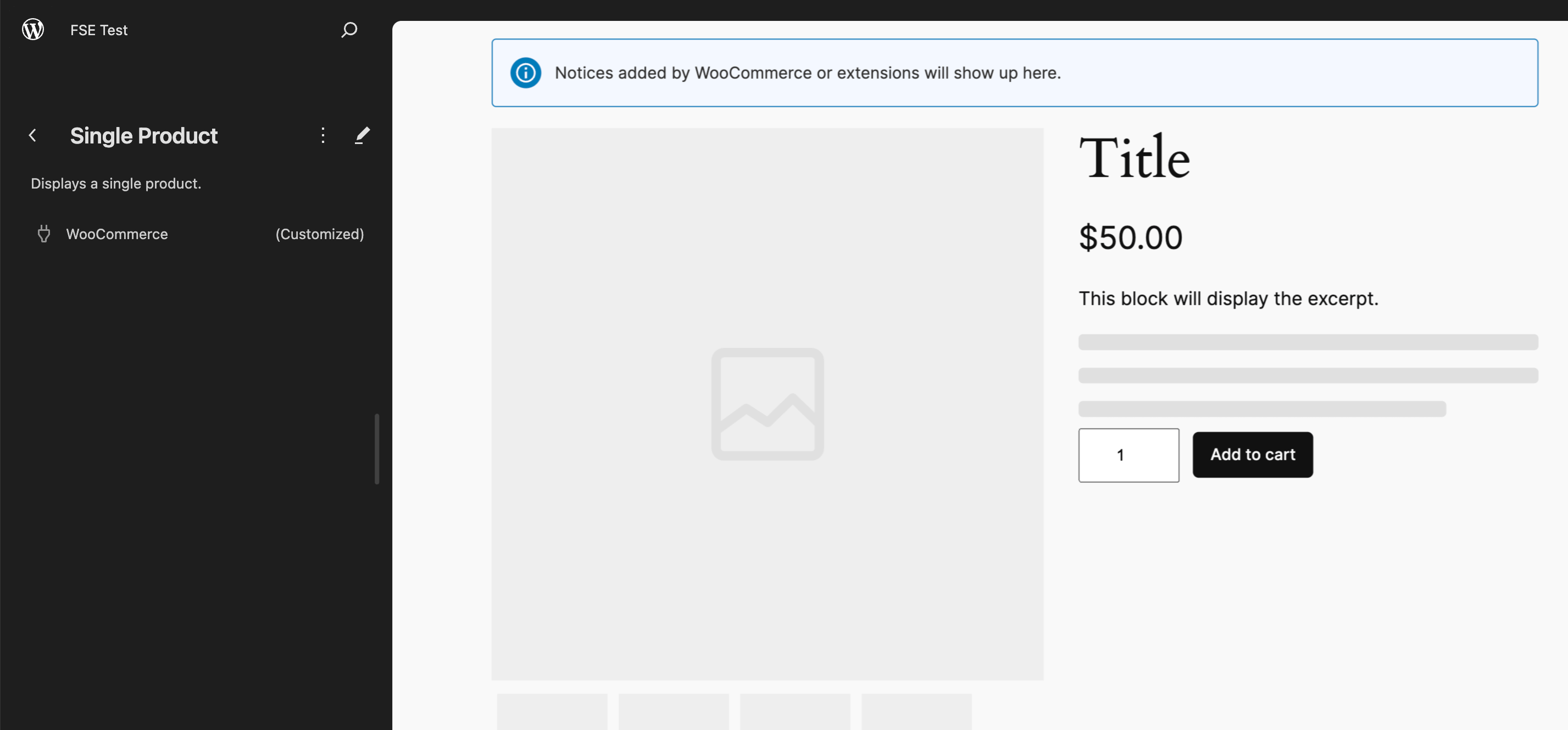
We’ve already introduced the concept of Full-Site Editing (FSE) earlier in this article, which is WordPress’ built-in way to design and structure pages. While it’s not a full-fledged page builder, we still wanted to include it in this comparison as it offers some advantages:
- This is the future of WordPress and is being actively developed.
- It is built-in, so you don’t need additional plugins.
- It’s free of charge, while page builder plugins are a paid expense.
For this test, we used the Twenty Twenty Four theme, which is the first official WordPress theme supporting Full-Site Editing.
Let’s finally dive into some numbers!
Google PageSpeed
Google’s PageSpeed Insights show a near-perfect score for our single product page built with WooCommerce Blocks:
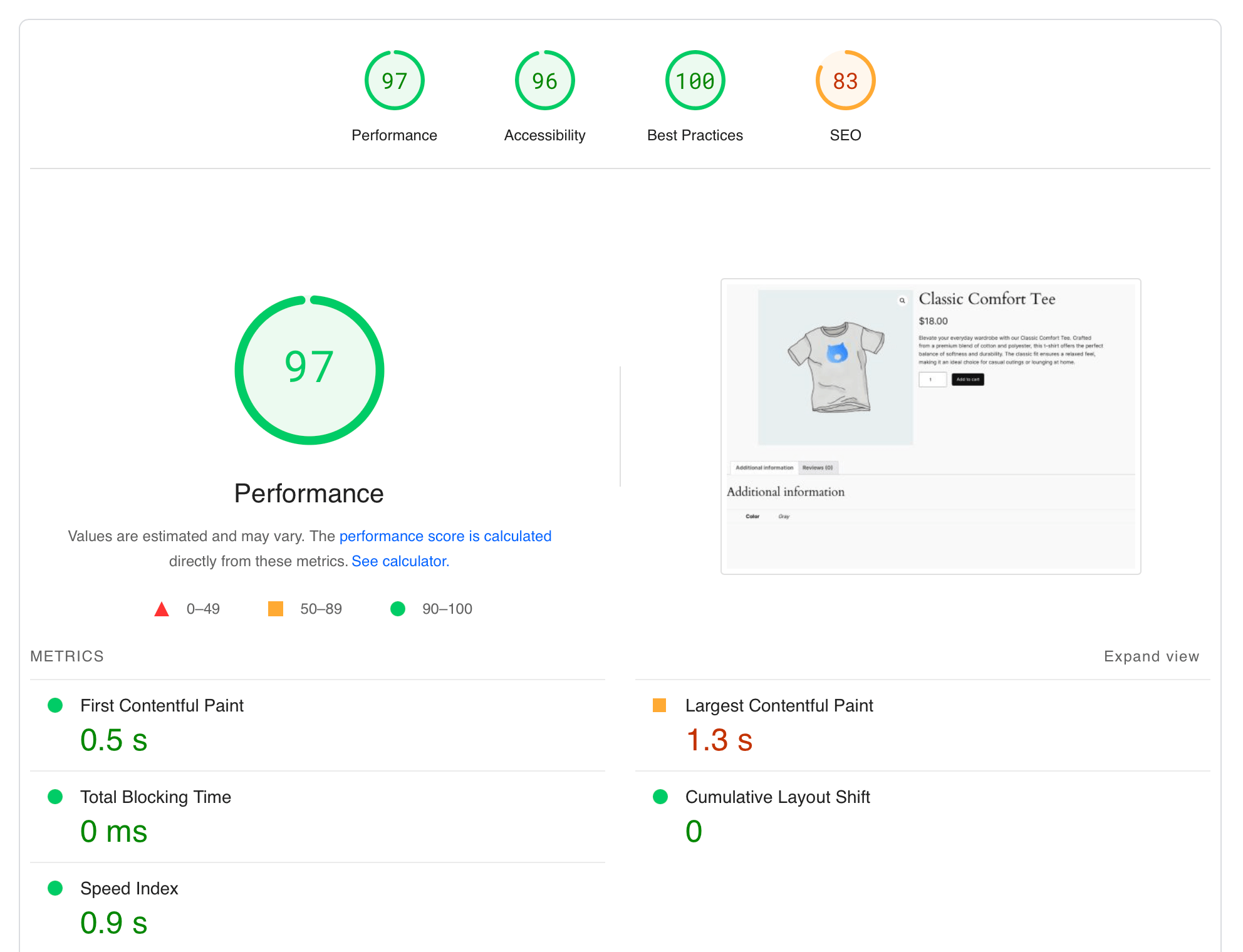
- Total score: 97
- First contentful paint: 0.5 s
- Total blocking time: 0 ms
- Speed index: 0.9 s
- Largest contentful paint (LCP): 1.3 s
- Cumulative layout shift (CLS): 0
Pingdom
Pingdom shows the page is fully loaded (including scripts and images) in about 0.9 seconds, which is quite good considering it’s below 1 second and our test sites do not benefit from optimization or caching plugins.
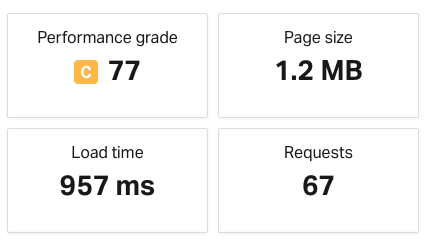
The reason Pingdom’s performance grade is a lower score is that the total page size exceeds 1 megabyte. Unfortunately, both WooCommerce and Full-Site Editing include a few large scripts on the website.
- Performance grade: 77/100
- Page size: 1.2 MB
- Load time: 957 ms
- Total number of requests: 67
Time To First Byte
The average Time To First Byte is only 0.5 seconds, which is a very good result. If we access the site from the same location as it is hosted, that drops down to 0.3 seconds.
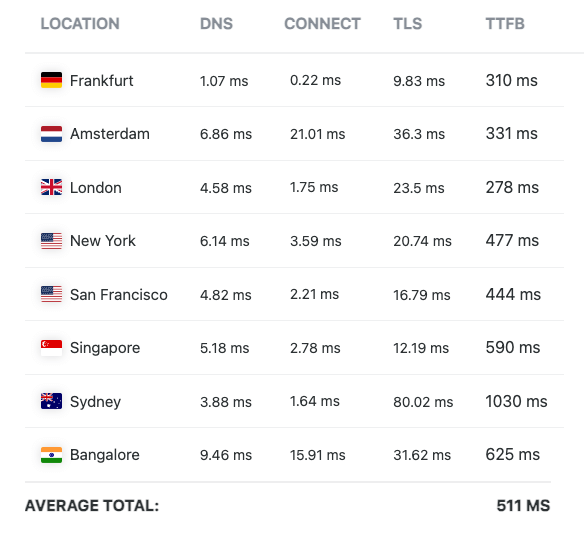
Performance profile
We measured the individual execution time of WooCommerce and the theme. Since we don’t use a separate page builder (only the built-in WooCommerce blocks), it’s logical that WooCommerce does most of the processing for this page. Total execution time was 0.51 seconds, which was 99% WooCommerce and 1% other theme functions.
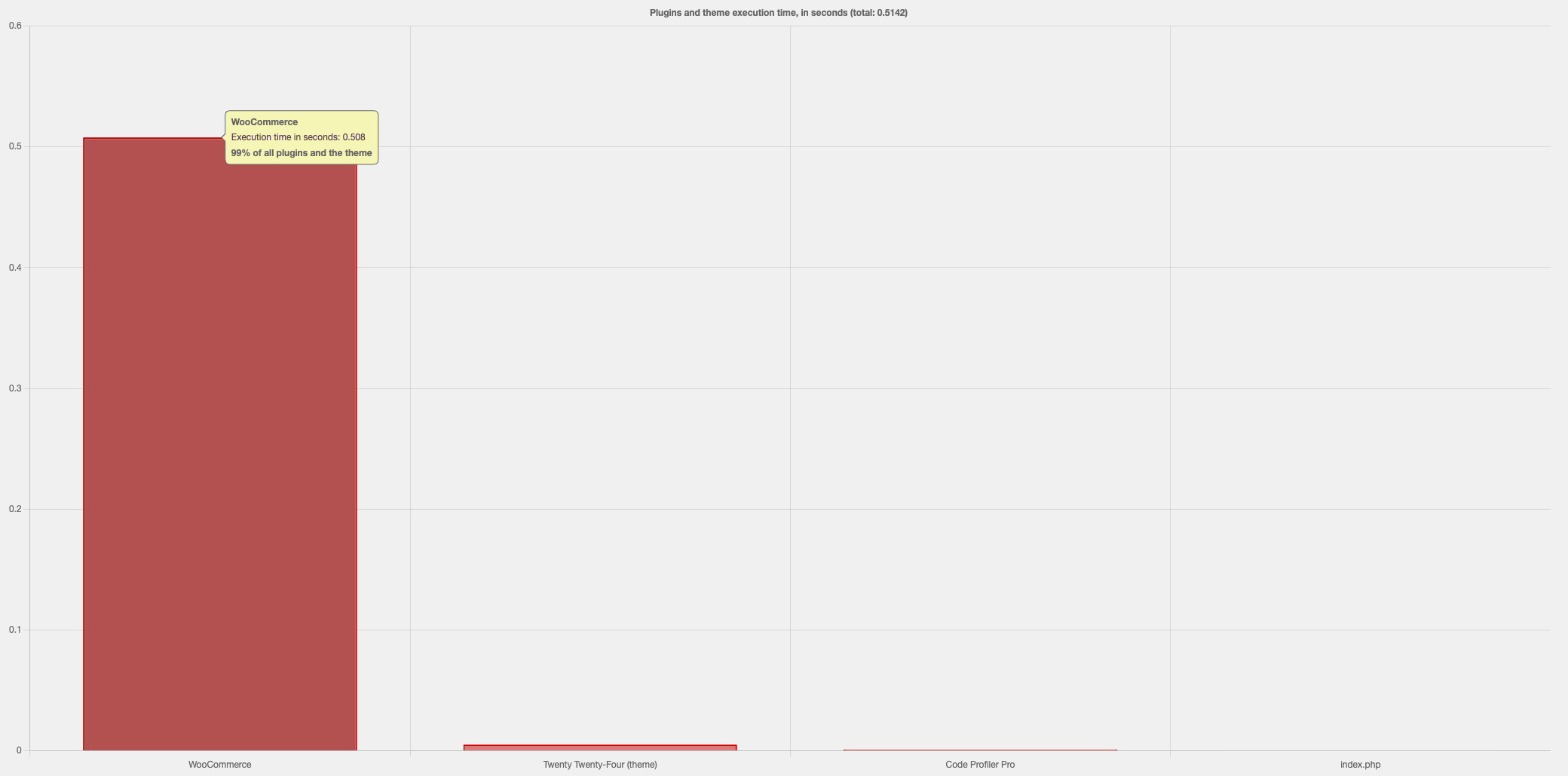
Conclusion
Without a doubt, Full-Site Editing with WooCommerce blocks is the fastest contestant on the list. Unfortunately, we can’t recommend it yet because it lacks many of the advanced settings other page builders have.
Moreover, many plugins don’t integrate with FSE and WooCommerce blocks yet, simply because the authors of the blocks don’t provide 3rd-party plugin authors with a proper way to write their integrations. Our own Studio Wombat plugins are integrated as much as possible.
On the flip side, Full-Site Editing is getting better with every WordPress and WooCommerce release, so we are firm believers it will be the way to go in the future!
2. Breakdance
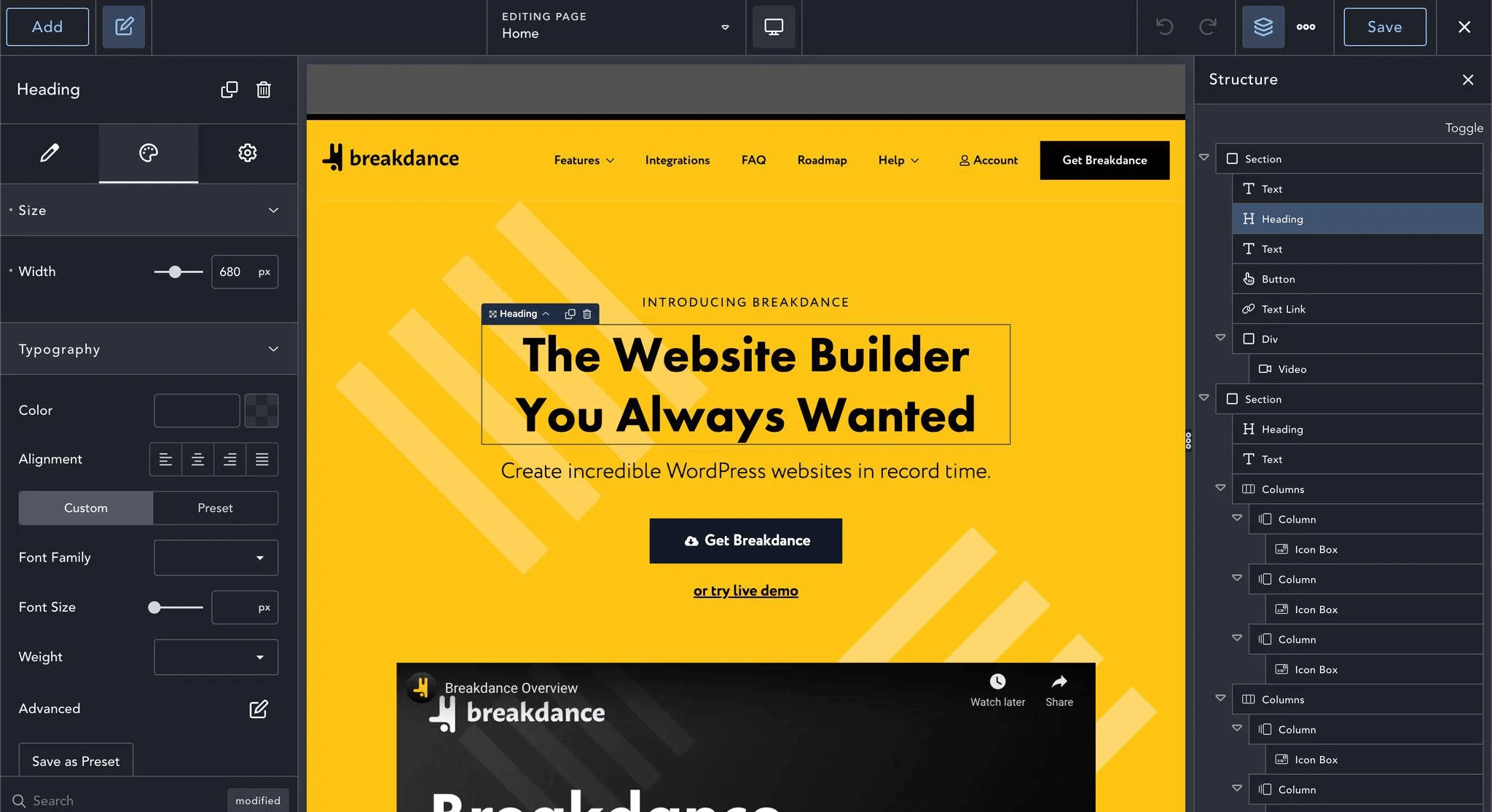
Breakdance is the youngest page builder plugin in this list. The first version was released in September 2022 and was created by the developers behind the popular WP All Import plugin.
Their aim is to be a modern page builder without technical depth like some older builders might have. Let’s see how this new builder does in terms of speed!
Breakdance looks nice and modern. However, something unintuitive was that I did have to add a “product builder” component to get started. This was the only way to create a single product page in WooCommerce using Breakdance.
Google PageSpeed
Google’s PageSpeed Insights shows a perfect score: 100% in terms of performance!
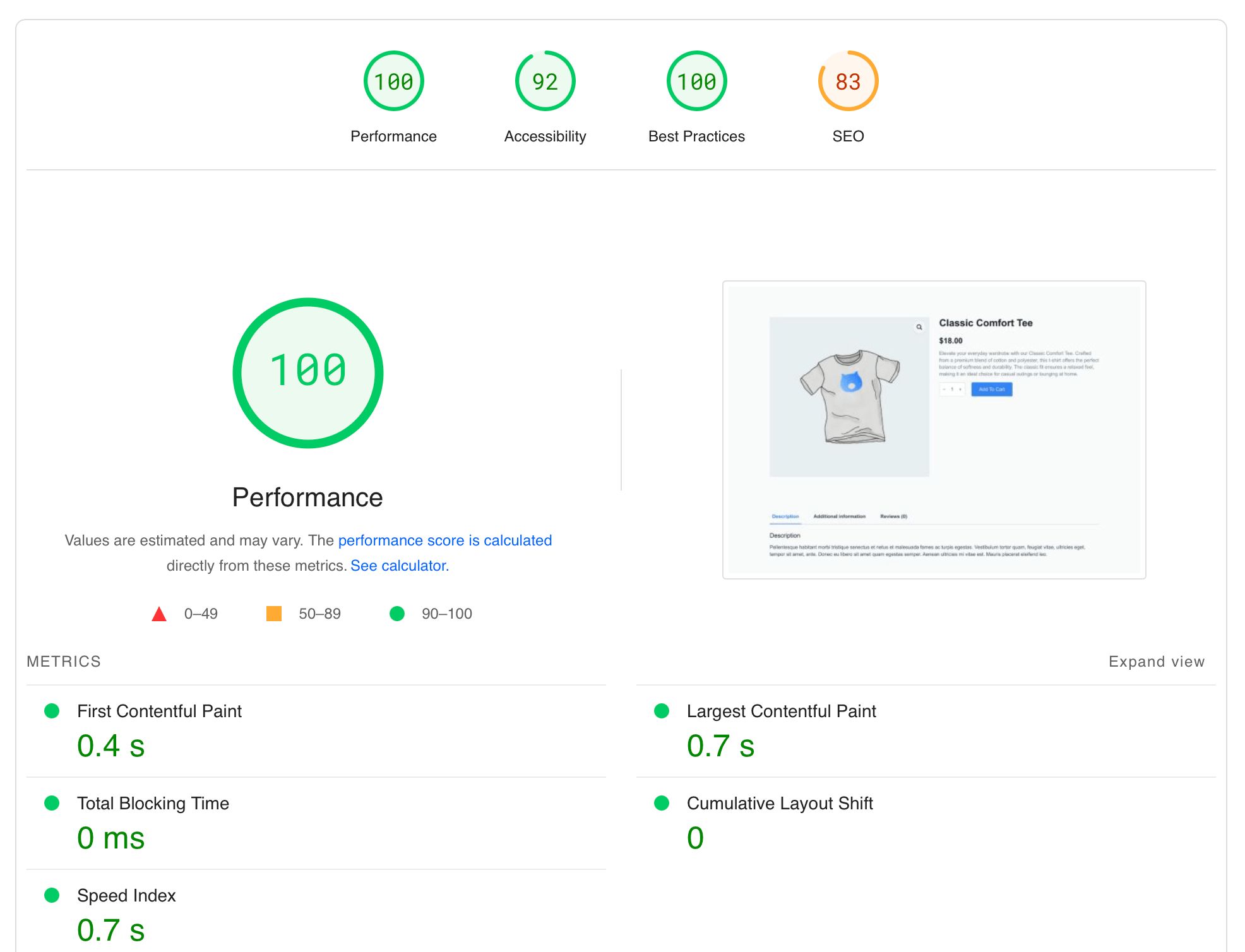
- Total score: 100
- First contentful paint: 0.4 s
- Total blocking time: 0 ms
- Speed index: 0.7 s
- Largest contentful paint (LCP): 0.7 s
- Cumulative layout shift (CLS): 0
Pingdom
Pingdom shows the page is fully loaded in about 1.2 seconds, which is slower than FSE themes (as is to be expected), but still quite good!
The reason Pingdom labels this performance as grade C is because of the number of requests and load time above 1 second.
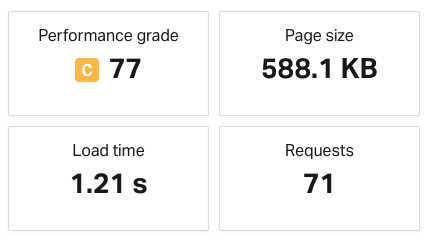
- Performance grade: 77/100
- Page size: 0.6 MB
- Load time: 1.21 s
- Total number of requests: 71
Time To First Byte
The average Time To First Byte is only a little slower than FSE themes at 0.59 seconds, which is still a very good result.
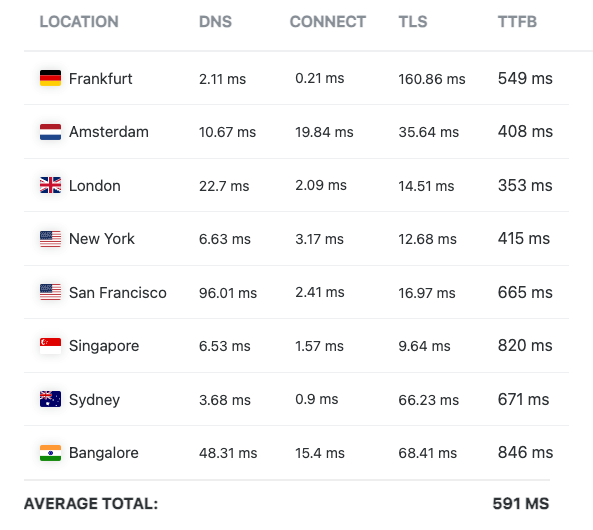
Performance profile
Breakdance took only 0.18 seconds to render the single product page, which was 35% of the total execution time of 0.52 seconds:
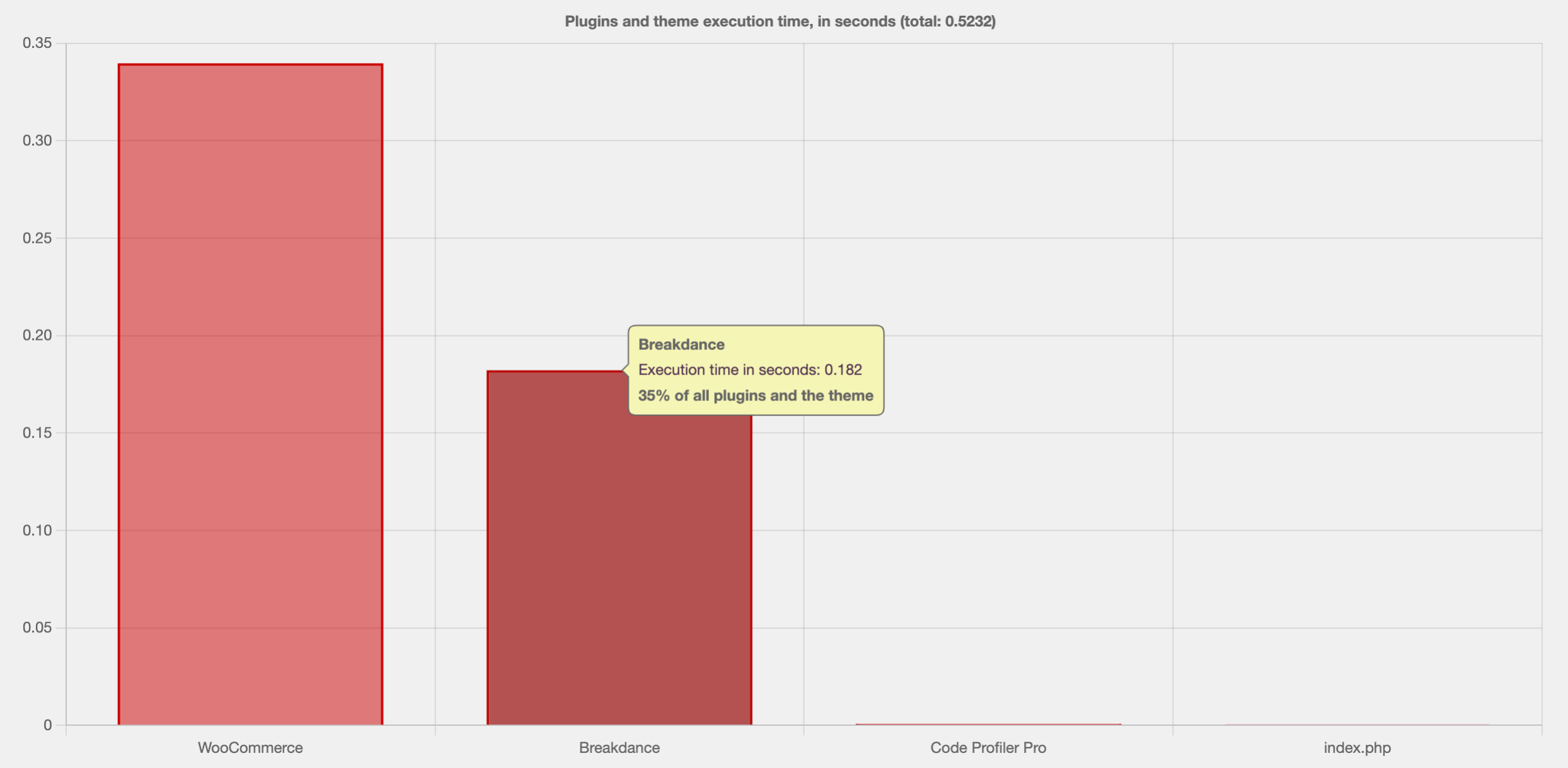
Conclusion
It’s still early days for Breakdance, so it’s hard to predict where the page builder will be in a year from now. Nonetheless, our speed test looks very promising and puts Breakdance at a well-deserved 2nd place!
3. Elementor

Elementor is the most popular WordPress page builder around today. It’s estimated that it has a 71% market share between other page builders and the free version is installed on more than 5 million websites. Thanks to its large community, there are plenty of tutorials or help videos available to get you started in no time.
Elementor allows users to visually design and customize their WordPress websites through a drag-and-drop interface, making it accessible for users without coding knowledge.
Elementor was the easiest to use out of all the page builders tested for this article. I didn’t need to dive into documentation to get started. Setting up the product page was also simple thanks to the 14 built-in WooCommerce widgets.
Google PageSpeed
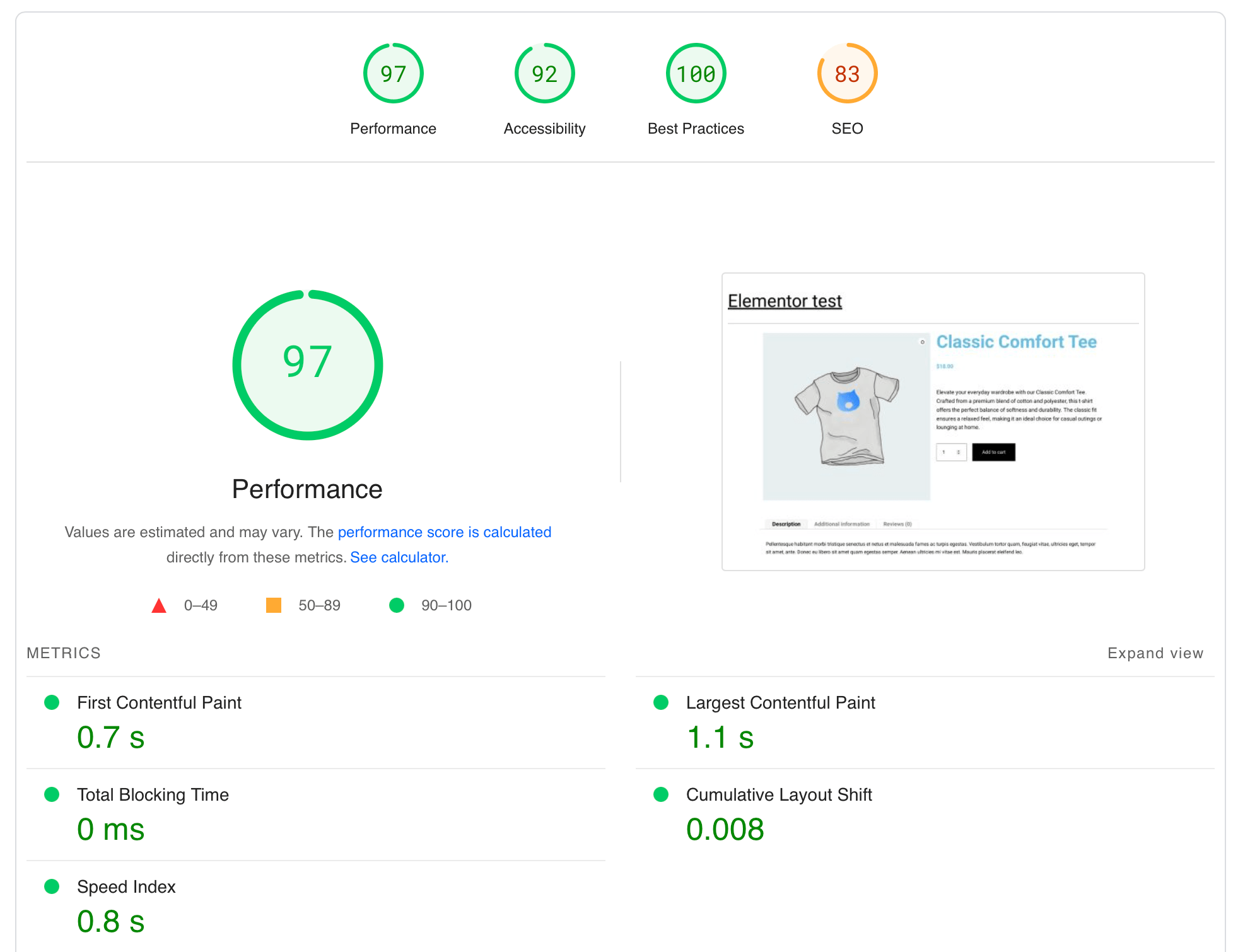
- Total score: 97
- First contentful paint: 0.7 s
- Total blocking time: 0 ms
- Speed index: 0.8 s
- Largest contentful paint (LCP): 1.1 s
- Cumulative layout shift (CLS): 0
Pingdom
The Pingdom tool shows the page loads in 1.39 seconds, which is the lowest score of this list:
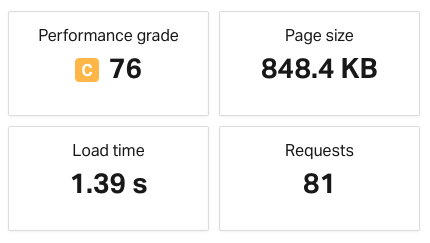
- Performance grade: 76/100
- Page size: 0.85 MB
- Load time: 1.39 s
- Total number of requests: 81
Time To First Byte
The average Time To First Byte is 0.63 seconds.
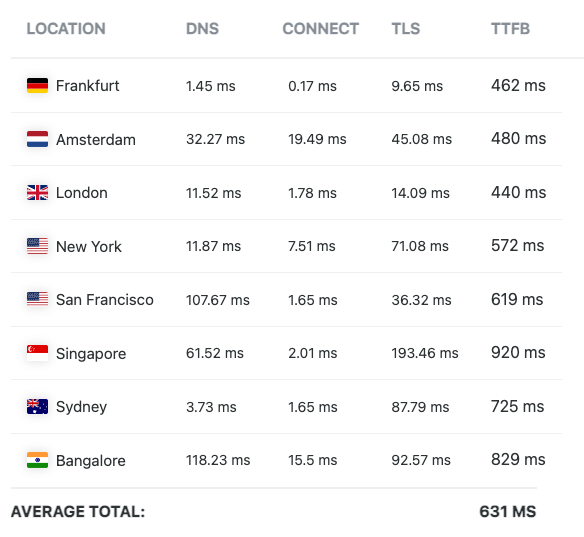
Performance profile
Here is the execution time per plugin for our Elementor site:
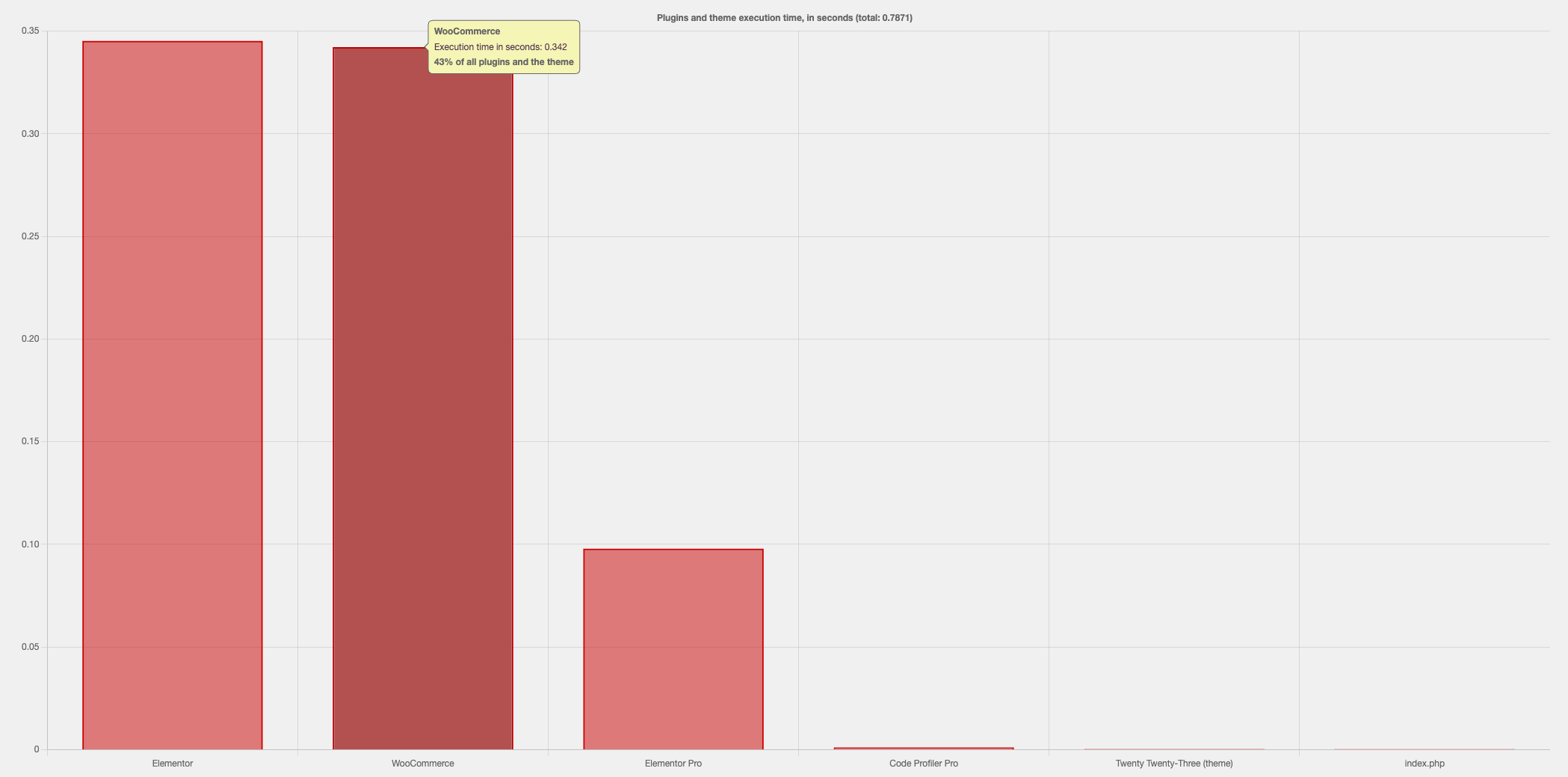
As you can see, Elementor is quite heavy and requires the same amount of processing time as WooCommerce (which is 0.34 seconds).
4. Beaver Builder
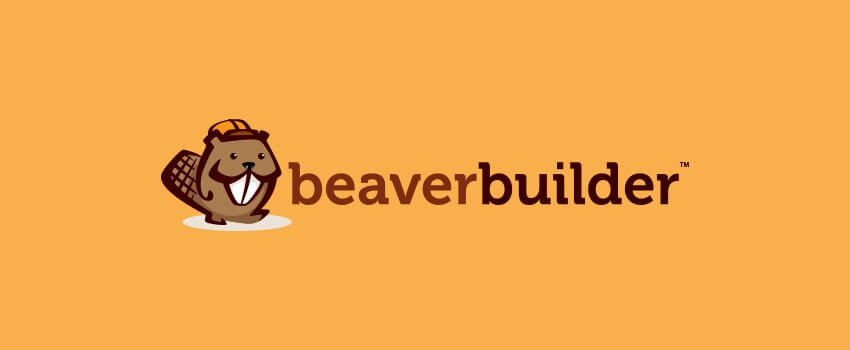
We’re big fans of software with a mascot! Beaver Builder is a user-friendly page builder, offering a drag-and-drop interface to simplify the process of creating and customizing web pages. What sets Beaver Builder apart is its emphasis on clean code output and compatibility with various themes.
It's the only page builder in the list that requires an additional plugin. If you want to use Beaver Builder to design WooCommerce product pages, you need to use the Beaver Themer plugin to be able to select WooCommerce components.
Google PageSpeed
Google’s PageSpeed Insights are very similar to the results when using Full-Site Editing:
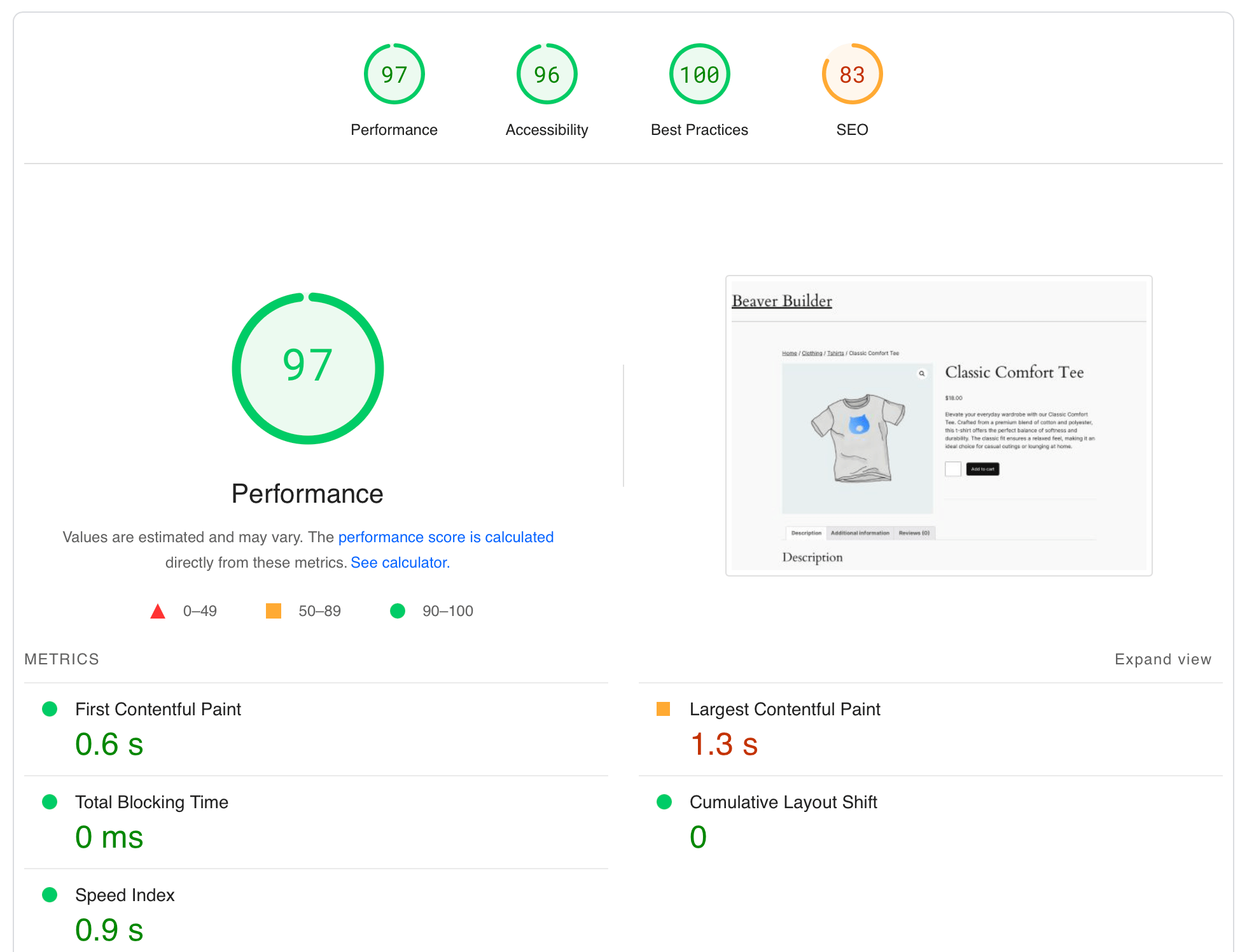
- Total score: 97
- First contentful paint: 0.6 s
- Total blocking time: 0 ms
- Speed index: 0.9 s
- Largest contentful paint (LCP): 1.3 s
- Cumulative layout shift (CLS): 0
Pingdom
Pingdom shows the page loads in 1.14 seconds, which is just a little faster than Breakdance:
- Performance grade: 77/100
- Page size: 1.2 MB
- Load time: 1.14 s
- Total number of requests: 67
Time To First Byte
The average Time To First Byte is 0.68 seconds. That’s not bad, but it’s slower than some other contenders in this article.
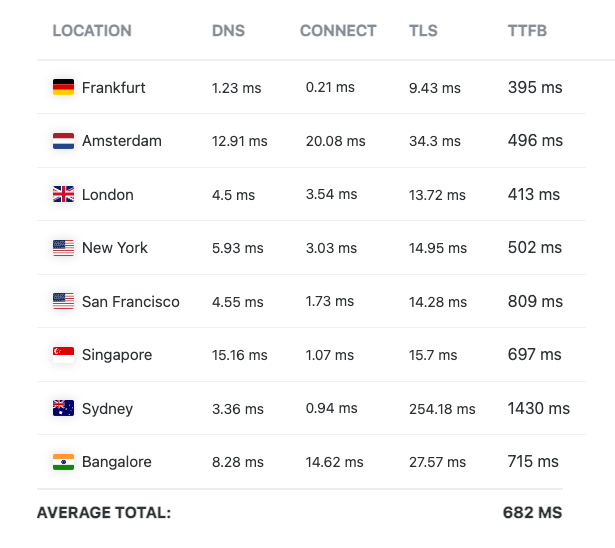
Performance profile
Sadly, both Beaver Builder plugins need almost half a second (0.452 seconds, to be exact) to render the page.
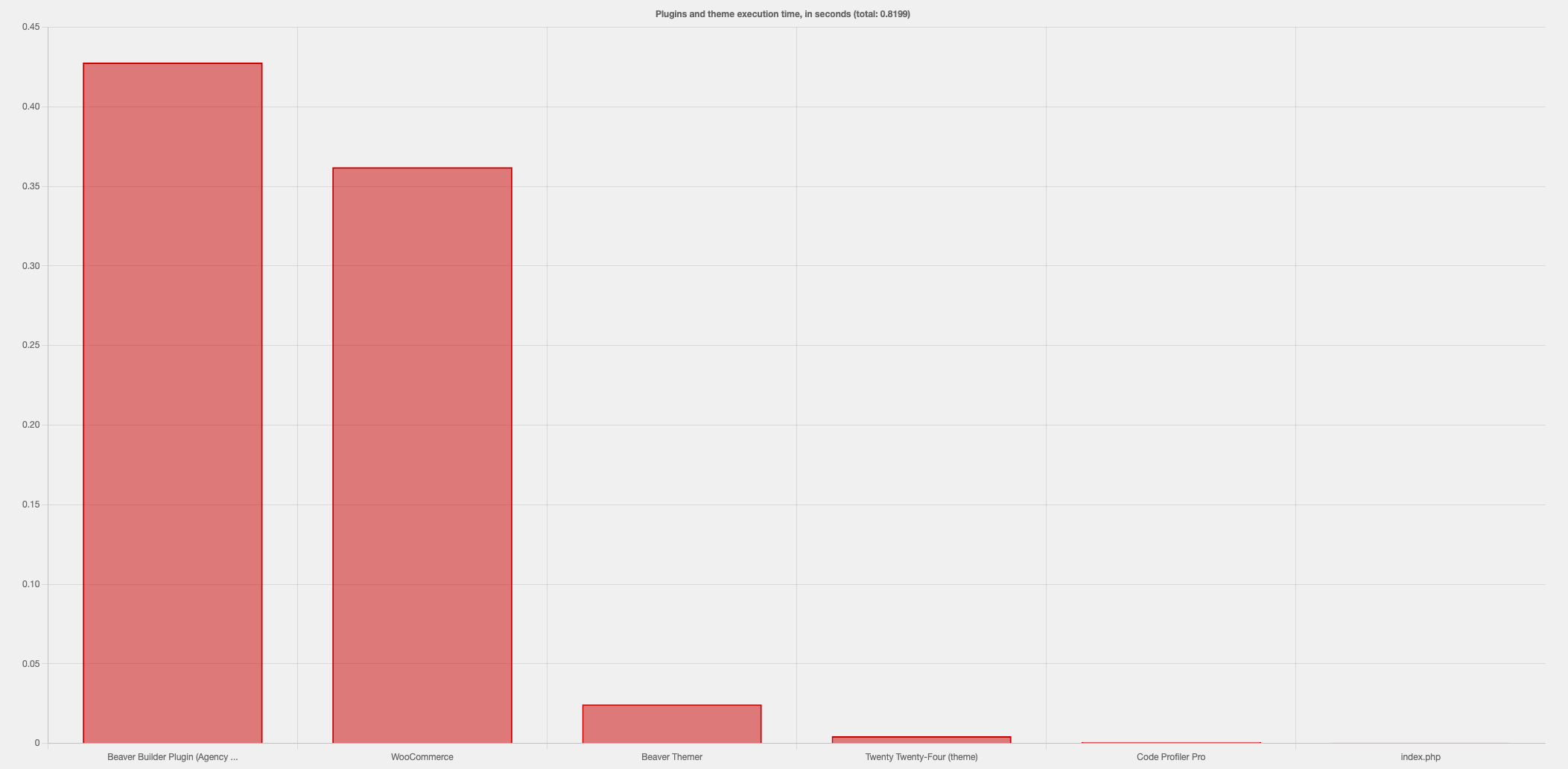
Conclusion
While all other page builders only require one plugin, Beaver Builder requires 2 plugins to work well with WooCommerce. This in itself isn’t a problem, but the builder is a bit slower than others in this article.
5. Divi
Divi is another popular visual theme builder that lets you design your WooCommerce pages without writing any code.
With Divi, you can create pages for your online store and view all design changes in real time. All Divi templates and elements are fully responsive across all devices, so you don’t have to worry about mobile users. In addition to this, Divi also comes pre-built with global elements and styles that help transform your WooCommerce site in a few clicks, a feature that’s valued by less tech-savvy store owners.
Divi felt a little slow in the backend and was my least favorite builder. Despite my opinion, Divi has an impressive 4.9 stars out of 5 on Trustpilot from over 23,000 reviews!
Google PageSpeed
Google’s performance report is very positive about Divi:
- Total score: 98
- First contentful paint: 0.5 s
- Total blocking time: 0 ms
- Speed index: 0.7 s
- Largest contentful paint (LCP): 1.1 s
- Cumulative layout shift (CLS): 0
Pingdom
- Performance grade: 77/100 (grade C)
- Page size: 0.72 MB
- Load time: 1.01 s
- Total number of requests: 69
Time To First Byte
The average Time To First Byte was 0.75 seconds for the single product page on our Divi test site.
Performance profile
Here is the execution time per plugin for our Divi site:
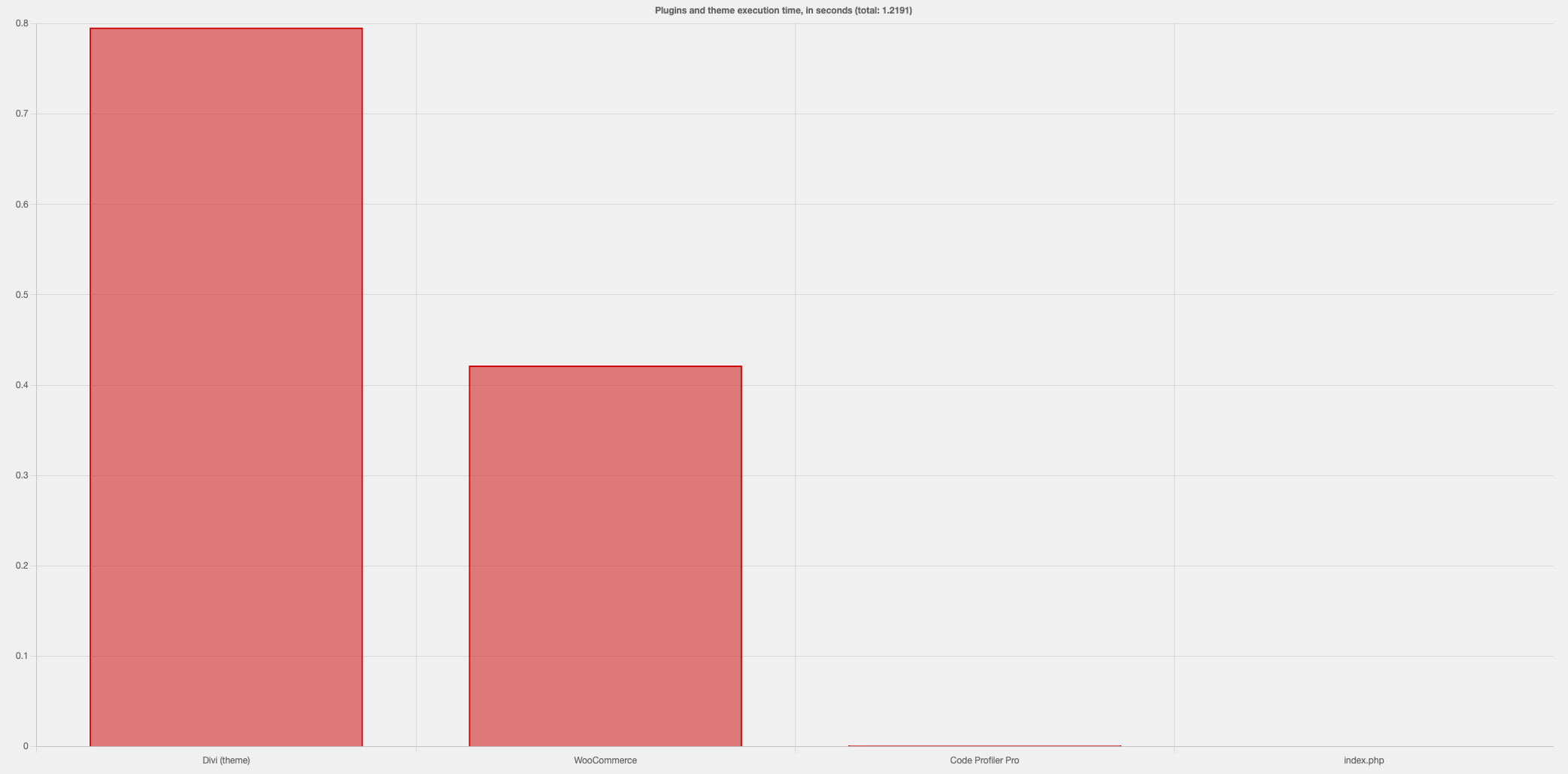
Divi is very heavy and needed almost 0.8 seconds to render the page!
To summarize: what’s the fastest WooCommerce page builder?
There can only be 1 winner in this comparison. Below you can see an overview of how the fastest page builders for your WooCommerce site rank, according to PageSpeed Insights and the TTFB scores, and what the average combined score for those 2 tools is:
| Page Builder | Ranking | PageSpeed Insights score | TTFB score | Average score |
|---|---|---|---|---|
| Full-Site Editing + Blocks | 1 | 97 | 74 | 85.5 |
| Breakdance | 2 | 100 | 70 | 85 |
| Elementor | 3 | 97 | 68 | 82.5 |
| Beaver Builder | 4 | 97 | 66 | 81.5 |
| Divi | 5 | 98 | 62 | 80 |
Full-Site Editing is built into WordPress, so it’s not a surprise that it ranks 1st. Breakdance, being the new kid on the block and a true page builder, is a very close 2nd.
Further reading
We’re creating a “Fastest X for WooCommerce” blog series. You can read our independent research on the fastest WooCommerce themes.
